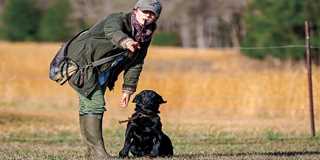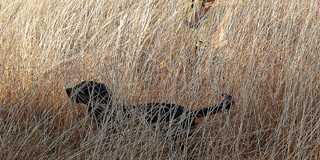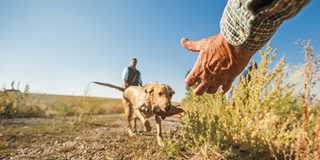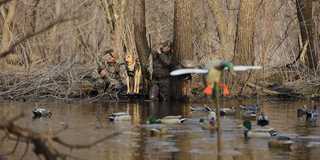Training the Wildrose Way
This innovative program can help you train a rock-solid retriever, using positive training methods and a little algebra
This innovative program can help you train a rock-solid retriever, using positive training methods and a little algebra

By Tom Davis
Class is in session at Wildrose Kennels. On any given day at the kennels Mississippi facility, located on 157 parklike acres near Oxford, youll see handsome Labrador retrievers of all ages and levels of education being put through their paces by a platoon of olive- and khaki-clad trainers. Some of these Labs may be walking at heel or receiving their daily refresher course in basic obedience; others may be doing water retrieves on one of several ponds that dot the property; still others may be honing their upland hunting skills in the fields of tawny broomsedge mowed and manicured for that purpose.

Photo Katie Behnke/UKLABS.COM
Youll also likely see puppies being steadied in the pigeon pen, led up and down ramps and over low obstacles, or even doing short, simple retrieves along a woven-wire fence. As you begin to view things through the lens of what is called the Wildrose Way, youll understand that the fence serves as a defined edge that helps form and root the habit of taking the straightest possible line, out and back, while making a retrieve.

Photo Katie Behnke/UKLABS.COM
On this particular day, however, people are being trained as well. Several of us meet in the log cabinstyle building that houses Wildroses retail store and classroom, which is decorated with various pieces of taxidermy and an antique hammer gun said to have belonged to William Faulkner. In front of the group, Mike Stewart is holding forth. Tall, rangy, and charismatic, with expressive hands and a rapid-fire delivery, Stewart is so well known to the outdoor world in general and DU members in particular that he hardly needs an introduction.
Officially, Stewart is the president of Wildrose International; more to the point, hes the architect of the Wildrose Way, the systematic, progressive, altogether positive approach to training with the ultimate goal of creating a gentlemans gundog. Or, as Stewart likes to call them, dogs of duality, meaning dogs that are as much a pleasure to live with as they are to hunt with; dogs that are important members of the family as well as productive, reliable partners afield.

Photo Katie Behnke/UKLABS.COM
The three other people in the room, Scott Wilson, Will Zizmann, and Adam Hyland, all assistant trainers on the Wildrose team, are taking what amounts to a graduate-level seminar in retriever training. Their textbook is Sporting Dog and Retriever Training: The Wildrose Way, authored by Stewart in 2012 with help from Orviss Paul Fersen. The book is 250 pages, and todays students are a little more than halfway through, at the point in the program where the pup is about eight months old and ready to be introduced to the gun.
Everyone in the room understands how to safely introduce a puppy to gunfire (even me). They also understand that gunshyness, one of the great banes of sporting dogs the world over, is a man-made condition. Accordingly, Stewart focuses on the human side of the equation.
Its important to get your clients thinking in a progressive manner, he explains, and not succumb to the temptation to introduce gunfire too early, when the pups not ready for it. In some dogs whose introduction to gunfire was rushed, Ive actually seen a kind of displacement, almost like PTSD. They dont seem affected at first, but then, several months later, they cower at the sight of a shotgun.

Photo Katie Behnke/UKLABS.COM
So you have to emphasize the progression, the causal relationship from one step to the next. Youre looping back to link up skills the dog has already learned, and thats allowing you to continually move forward. This seems like a good place to revisit the mathematical formula for training a gundog. Tom, did you know that theres such a thing?
Uh, no . . . Im beginning to feel like Im in one of those nightmares where I show up for the final college exam only to realize I havent attended a single class.
Together, Stewart and his students proceed to fill this gaping hole in my education.
First, you have R. What does R stand for? Stewart asks.
Repetition, the students answer.
Right. Then C for . . .
Consistency.
Yes. R plus C. Then, minus . . .
B. For boredom.
Correct. Boredom is something you really have to watch out for, especially with more intelligent dogs, Stewart says. Some of the ways we can prevent boredom include changing up the location and time of day of the drill, introducing other dogs, and enhancing the experience by using a higher value retrieving objecta bird instead of a bumper, for example.

Photo Katie Behnke/UKLABS.COM
Now, Stewart continues, we have R plus C minus B, multiplied by VC, which stands for . . .
Variable conditions.
Right. And our standard for that is what?
That the behavior has to be demonstrated five times, under five different sets of conditions, in order to be called a PH, or predictable habit.
Thats right, Stewart says. You have to identify all the variablesshallow water, flooded timber, and so on. We practice for them because dogs dont generalize well. If I show you how to put a widget together, then ask you to do it while standing in water, you can. Its not the same for dogs. You have to show them here, and you have to show them there. Thats why we say five times in five different places.
Stewart uncaps a marker and spells the equation out on a whiteboard: R + C (B) x VC = PH, as proven by 5x5.
I wonder if its getting hot in here, or if its just me.
Ive come to Wildrose to pick Stewarts brain about what he calls the Seven Core Skills. These fundamental skills are the hallmarks of a gentlemans gundog. Every retriever should demonstrate competency with them before you take him hunting.

Photo Chris Dickinson/UKLABS.COM
What Im discovering, though, is that its not quite that simple. Theres a famous John Muir quote to the effect that when you try to pick out anything by itself, you find it hitched to everything else in the universe. Without putting too fine a point on it, trying to talk about a piece of the Wild-rose Way in isolation, separate from all the other pieces, is something like that. You find that theyre all interrelated, interconnected, interdependent. Mastery of any single skill comes only after all the skills ahead of it in the progression have been mastered. When a skill is mastered, its the logical, natural consequence of everything thats been accomplished before it.
And while you can make the argument that every successful training program operates on this principle, it seems especially critical to the success of a program like the Wildrose Way. Its a program in which concepts such as force and pressure arent in the vocabulary. The dogs behaviors are molded not on his aversion to something unpleasant happening if he fails to comply, but on his expectation of something pleasant happening when he does.
One evening, relaxing over a glass of bourbon with Stewart in the airy ranch-style home he shares with his wife, Cathy, and the current DU dog, Deke (who keeps such a low profile on his bed beside the fireplace that for a long time I dont realize hes in the room), I ask Stewart to expound on the seven skills.
Youre old enough to remember making popcorn garlands for Christmas, arent you? he begins. The seven core skills are something like that. You string the individual pieces of popcorn together to make a garland, then you loop the garlands together. Of course it all begins with obediencewhich is a vast field unto itselfthen moves on to what we call the three Ds of steadiness: deny, delay, and diversion. From there it progresses to delivery to hand, lining, and so on.

Photo Travis Mueller, Avery Outdoors
Its all progressive; it all loops together. You never put anything in that you have to take out later. Youre always asking the dog to give you a little more, but you have to remember that they dont learn from failure. You have to set them up to win. Thats why one of our training maxims is Start close, then stretch it out. As soon as the dog gives you exactly what you want, reinforce the behavior with praise. If you dont get what you want, back up, simplify, and start over.
Stewart pauses to sip his drink, then continues. The walking baseball drill we worked on this morning with Will, Adam, and Scott is a good one for reinforcing core skills. It pulls together obedience, steadiness in the face of diversion, responding to whistle and hand signals, making left- and right-hand casts, lining, and marking. Once your dogs got it down on fairly open ground you can move to heavier cover and add the hunting dimension as well.
Ultimately, there are four levels of training: yard work, which is primarily about instilling obedience; field work, where we do foundational drills like walking baseball, switching on doubles, and the other ones you saw today; transitional work, where we essentially scrimmage in situations similar to actual hunting conditions; and finally hunting itself, where we put the dog out there, evaluate his performance, and determine what we as trainers need to work on.
It all comes back to preparation. We have a saying around here: The first time your dog sees something shouldnt be at sunrise on opening day.
A cold rain greets us the following morning, a rain that will turn to snow later in the day and prompt early dismissal of the Oxford public schools. Its the kind of weather the Labrador retriever was designed forthe weather in which the breeds character was forged. If the enthusiasm of the human half of the partnership is a bit dampened by the conditions, the dogs are clearly loving it.
The mornings training agenda focuses on upland work, quartering cover, honoring, remaining steady when another dog is sent for a retrieve, dealing with multiple falls (typical of gunning a covey rise of bobwhite quail or a cornfield flush of pheasants), and learning to mark by sound when a bird falls unseen in tall grass, brush, or timber. The command hi-loss is introduced. Its a Scottish term thats the equivalent of hunt deadindispensable for a dog expected to retrieve on land.
Stewart watches a young Wildrose Lab absolutely shred the broomsedge searching for a hidden bumper while his trainer croons hi-loss, hi-loss. You always want to build the habit close, then gradually extend it, Stewart says. Theres a huge amount of intuitiveness that goes on if were creative enough as trainers to bring it out in the dog.
For the dogs who are further along in the progression, the session ends with a time-delayed memorya retrieve of an object they saw fall prior to engaging in the main drill. Its an example of one of Stewarts bedrock training principles known as the counter-skill, meaning a task that requires the dog to draw on a different part of his skill set and use his mind in a different way than he has over the previous few minutes. Several of these exercises require that the dogs go from open ground into woods, and its deeply impressive to watch them punch through the thick stuff to complete their retrieves. These are dogs that know their business, and they wont be denied.
Back in the classroom, where were grateful to be out of the rain, Stewart uses the mornings fieldwork as a springboard for a discussion on the blind retrieve.
Its not as if you wake up one morning, Stewart says with a little laugh, and say I think Ill teach my dog how to do blind retrieves today. There are four parts to a blind. The first is that the dog has to be able to take a straight line and push it, the way we saw them do this morning with the time-delayed memory drills. The second is that he has to handle, so that if he gets on the wrong line you can stop him and put him back on the right one. The third, which is another thing we saw this morning, is that he has to know how to hunt cover.
The fourth is that he has to have confidence in you. He has to have total faith that what youre telling him to do will result in him finding a bird and making a retrieve.
That, it seems to me, is the loop that brings everything around full circle: the creation of an unshakable bond of trust between a hunter and his dog.
Ducks Unlimited uses cookies to enhance your browsing experience, optimize site functionality, analyze traffic, and deliver personalized advertising through third parties. By continuing to use this site, you agree to our use of cookies. View Privacy Policy